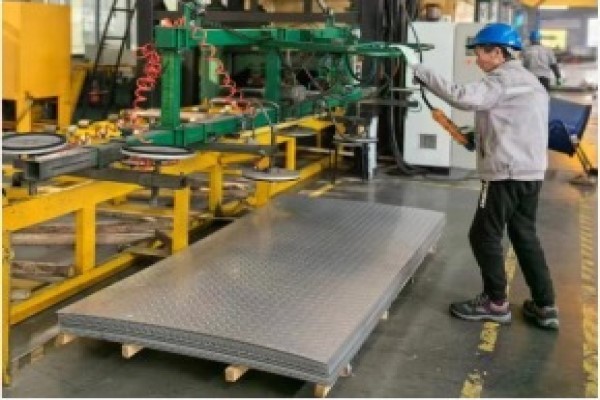How Stainless Steel Checker Plates Enhance Workplace Safety?

Workplace safety is a top priority for any industry, particularly those that involve heavy machinery, frequent foot traffic, and potentially hazardous environments. Slips, trips, and falls are among the most common workplace injuries, and reducing these incidents can significantly improve the safety and productivity of a worksite. One effective solution to mitigate these risks is the use of stainless steel checker plates.
Stainless steel checker plates are widely recognized for their durability, strength, and anti-slip properties. They are used in a variety of settings, from industrial floors and staircases to loading docks and ramps. Stainless steel sheet suppliers often offer a range of these checker plates, ensuring the right specifications are available for your application.
The Role of Stainless Steel Checker Plates in Preventing Slips and Falls
One of the most critical safety features of stainless steel checker plates is their anti-slip surface. The checker or diamond pattern on the plate creates raised sections that provide additional traction for both foot traffic and machinery. This design helps prevent slips, particularly in environments where surfaces may become wet or oily.
Enhanced Traction: The raised pattern on the surface of the checker plate improves grip, reducing the likelihood of slips, even in slippery conditions. This is particularly important in industries like manufacturing, shipping, and oil and gas, where liquid spills are common.
Durability and Stability: Stainless steel checker plates are made from high-strength materials that can withstand heavy foot traffic and the weight of machinery. Unlike other flooring materials that may wear down over time, stainless steel maintains its structural integrity, ensuring that the anti-slip properties remain effective for years.
Incorporating stainless steel checker plates into high-traffic areas, such as staircases and walkways, can dramatically reduce the risk of slip-related accidents. These plates are designed to handle harsh environments and continue to perform effectively under pressure.
Corrosion Resistance: Ensuring Long-Term Safety
One of the key advantages of stainless steel checker plates is their corrosion resistance. This characteristic is particularly valuable in environments exposed to moisture, chemicals, and extreme temperatures.
Corrosion Resistance: Stainless steel contains a minimum of 10.5% chromium, which reacts with oxygen to form a passive oxide layer. This layer protects the underlying material from corrosion. The result is a durable, long-lasting surface that maintains its anti-slip properties, even when exposed to corrosive environments such as marine settings or chemical plants.
Maintenance Benefits: The corrosion-resistant properties of stainless steel also reduce the need for frequent maintenance and replacement. This longevity not only contributes to long-term safety but also reduces downtime, keeping work sites operational and productive.
By using stainless steel checker plates in environments prone to corrosion, industries can ensure that their safety solutions remain intact and effective for extended periods, preventing costly accidents and repairs.
Load-Bearing Capacity and Structural Integrity
In addition to their anti-slip and corrosion-resistant properties, stainless steel checker plates are known for their impressive load-bearing capacity. This makes them suitable for applications involving heavy loads and industrial machinery.
Heavy-Duty Applications: Stainless steel checker plates are designed to support significant weight without bending or warping. This makes them ideal for use in loading docks, ramps, and platforms where heavy equipment or cargo is regularly moved.
Structural Integrity: The inherent strength of stainless steel ensures that the checker plates retain their shape and functionality, even under the stress of heavy machinery. This stability helps prevent accidents caused by flooring failures, such as cracks or collapses.
Using stainless steel checker plates in areas where heavy loads are frequent enhances workplace safety by providing a reliable, stable surface that can withstand the demands of an industrial environment.
Stainless Steel Checker Plates in Staircases and Ramps
Staircases and ramps are particularly prone to slip-related accidents, making them a critical area for safety enhancements. Stainless steel checker plates are commonly installed on stair treads and ramp surfaces to minimize the risk of falls.
Anti-Slip Stair Treads: By installing stainless steel checker plates on staircases, businesses can reduce the risk of workers slipping on stairs, particularly in outdoor or wet conditions. The raised pattern of the checker plate provides secure footing for individuals moving up and down stairs.
Ramps for Accessibility: Ramps used for accessibility purposes, as well as for loading and unloading, benefit from the traction provided by stainless steel checker plates. These plates ensure that both pedestrians and machinery can move safely across inclined surfaces, even in challenging weather conditions.
By incorporating stainless steel checker plates into the design of staircases and ramps, companies can create a safer environment for both workers and visitors.
Customization for Specific Safety Needs
One of the major benefits of stainless steel checker plates is their versatility. They can be customized to meet the specific safety needs of various industries and environments.
Custom Sizes and Thicknesses: Stainless steel checker plates are available in a range of thicknesses and sizes, allowing businesses to tailor them to the demands of their particular worksite. For instance, thicker plates can be used in areas that require additional load-bearing capacity, while thinner plates may be more suitable for light-traffic areas.
Cut-to-Length Services: Many suppliers offer cut-to-length services for **stainless steel checker plates**, ensuring that the plates fit perfectly within the intended space. This eliminates gaps or overlaps that could create tripping hazards.
The ability to customize stainless steel checker plates ensures that companies can implement safety solutions that are specifically designed to address the unique risks of their environment.
Compliance with Safety Regulations
In many industries, safety regulations mandate the use of anti-slip flooring materials in specific areas. Stainless steel checker plates are often used to comply with these regulations, as they meet the criteria for slip resistance, durability, and load-bearing capacity.
OSHA Compliance: The Occupational Safety and Health Administration (OSHA) has specific requirements for flooring in areas prone to slips and falls. Stainless steel checker plates help companies meet these regulations, ensuring that their workplaces are safe and compliant.
ISO Standards: Stainless steel checker plates often meet the requirements set by the International Organization for Standardization (ISO) for safety and performance. This guarantees that the plates are manufactured to the highest standards, ensuring reliability and safety in critical applications.
Using stainless steel checker plates to meet safety regulations not only protects workers but also helps businesses avoid costly fines and legal issues.
Conclusion
The use of stainless steel checker plates in the workplace is a practical and effective way to enhance safety. Their anti-slip properties, combined with corrosion resistance, load-bearing capacity, and durability, make them a reliable choice for reducing the risk of accidents in industrial and commercial settings.
Whether used in staircases, ramps, loading docks, or high-traffic walkways, stainless steel checker plates provide a secure, stable surface that helps prevent slips, falls, and other workplace hazards. By investing in these safety-enhancing materials, businesses can protect their employees, improve productivity, and ensure compliance with safety regulations.


